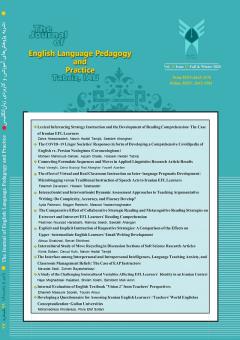How Has Political and Socio-economic Status affected Iranian EFL Learners’ Motivation to learn English
الموضوعات :
1 - Department of Foreign languages,Darab Branch,Islamic Azad University, Darab, Iran
الکلمات المفتاحية: EFL, Iranian learners, Motivation, Political, Social milieu,
ملخص المقالة :
This research study aims to investigate the motivation behind Iranian EFL learners' desire to learn English, with a specific focus on the political and socio-economic factors that influence them. The study takes into account the changing political and social landscape in Iran, which has been shaped by globalization and advancements in information and communication technology (ICT). In order to gain a deeper understanding of the driving forces behind Iranian EFL learners' English language acquisition, the researcher conducted interviews with thirty participants who had been studying English for approximately 3 to 6 years. The interviews were transcribed and the data was then analyzed using a systematic approach, including open, axial, and selective coding. The resulting model identified seven factors and twenty-seven categories that contribute to language motivation. These seven factors were a) The government’s foreign and economic policy, b) Transfer of religious and national ideology and patriotism, c) Academic and occupational aspirations, d) Improving social life, e) Fear of failure, f) International posture, and g) IT advancements. This model can serve as a valuable resource for informing future educational policies and curriculum development in Iran.
Ardavani, S., & Durrant, P. (2015). How have political and socio-economic issues impacted on the motivation of Iranian university students to learn English. English language teaching in the Islamic Republic of Iran: Innovations, trends and challenges, 35-45.
Ary, D., Jacobs, L. C., Sorensen, C., & Walker, D. (2013). Introduction to research in education: Cengage Learning.
Azarnoosh, M., & Birjandi, P. (2012). Junior high school students’ L2 motivational self system: Any gender differences. World Applied Sciences Journal, 20(4), 577-584. https://doi.org/10.5829/idosi.wasj.2012.20.04.2732
Borjian, M. (2013). English in post-revolutionary Iran: From indigenization to internationalization (Vol. 29). Multilingual Matters.
Brown, D. (1994). Teaching by Principles-An Interactive Approach to Language Pedagogy-Prentince Hall Regents.
Chalak, A., & Kassaian, Z. (2010). Motivation And Attitudes Of Iranian Undergraduate EFL Students Towards Learning English. GEMA online journal of language studies, 10(2).
Choubsaz, Y., & Choubsaz, Y. (2014). Motivational orientation and EFL learning: A study of Iranian undergraduate students. Procedia-Social and Behavioral Sciences, 98, 392-397. https://doi.org/10.1016/j.sbspro.2014.03.431
Coetzee-Van Rooy, S. (2006). Integrativeness: untenable for world Englishes learners? World Englishes, 25(3‐4), 437-450. https://doi.org/10.1111/j.1467-971X.2006.00479.x
Csizér, K., & Dörnyei, Z. (2005). The internal structure of language learning motivation and its relationship with language choice and learning effort. The Modern Language Journal, 89(1), 19-36. https://doi.org/10.1111/j.0026-7902.2005.00263.x
Dörnyei, & Ottό, I. (1998). Motivation in action: A process model of L2 motivation.
Dörnyei, Z. (1998). Motivation in second and foreign language learning. Language teaching, 31(3), 117-135. https://doi.org/10.1017/S026144480001315X
Dörnyei, Z., & Németh, N. (2006). Motivation, language attitudes and globalisation: A Hungarian perspective (Vol. 18). Multilingual Matters.
Dornyei, Z., & Ryan, S. (2015). The psychology of the language learner revisited. Routledge.
Dörnyei, Z., & Ushioda, E. (2009). Motivation, language identity and the L2 self (Vol. 36). Multilingual Matters.
Esmaeili, M., Mirzaei, A., & Roohani, A. (2024). The Interplay between Iranian EFL Learners’ Motivational Selves and Their Sociopragmatic and Pragmalinguistic Competence: A Structural Equation Modeling Approach. Teaching English as a Second Language Quarterly (Formerly Journal of Teaching Language Skills), 43(4), 33-56.
Gardner, R. C. (1985). Social psychology and second language learning: The role of attitudes and motivation. (No Title). https://doi.org/10.1037/h0083787
Gardner, R. C., & Lambert, W. E. (1972). Attitudes and motivation in second-language learning. https://doi.org/10.1016/B0-08-044854-2/00625-8
Golbakhshi, N. (2021). The Role of Iranian EFL Learners’ Motivation and Beliefs in Their Reading Comprehension Scores. Journal of Language Horizons, 5(2), 227.
Janati, M., & Marzban, A. (2014). The Relationship between Iranian EFL learners’ motivation and their English proficiency level. Journal of Studies in Learning and Teaching English, 2(6), 65-79. https://doi.org/10.3389/fpsyg.2022.869599
Khodadady, E., & Ashrafborji, M. (2013). Motivations underlying English language learning and achievement. Sage Open, 3(2), 2158244013484157. https://doi.org/10.1177/2158244013484157
Mahdavy, B. (2013). Gender and motivational orientations of English language learners: The case of high school students in Iran. Procedia-Social and Behavioral Sciences, 70, 1056-1061. https://doi.org/10.1016/j.sbspro.2013.01.158
Mehrpour, S., & Vojdani, M. (2012). Globalization and EFL learning motivation: A new perspective on integrative vs. instrumental motivation among Iranian learners of English. Open Journal of Modern Linguistics, 2(02), 43. https://doi.org/10.4236/ojml.2012.22006
Nasri, M., Shafiee, S., & Sepehri, M. (2021). An investigation of Iranian intermediate EFL learners’ L2 motivation and attitude in a computer-assisted language learning environment. Issues in Language Teaching, 10(1), 355-389.
Papi, M., & Teimouri, Y. (2012). Dynamics of selves and motivation: a cross‐sectional study in the EFL context of Iran. International Journal of applied linguistics, 22(3), 287-309. https://doi.org/10.1111/j.1473-4192.2012.00312.x
Rezai, A., Ahmadi, R., Ashkani, P., & Hosseini, G. H. (2025). Implementing active learning approach to promote motivation, reduce anxiety, and shape positive attitudes: A case study of EFL learners. Acta Psychologica, 253, 104704.
Sabri, R. A., & Hamid, R. (2023). Socioeconomic Status And Motivation Effect on Students' English Speaking Skill. International Journal of English Learning and Applied Linguistics (IJELAL), 3(2), 141-153. https://doi.org/10.21111/ijelal.v3i2.10117
Salehi, N., & Razmjoo, S. A. (2019). On the development of a model of political and socio-economic factors impacting Iranian EFL learners’ motivation to learn English. Journal of Language and Translation, 9(3), 137-152. https://doi.org/20.1001.1.20088590.2019.9.3.10.2
Taguchi, T., Magid, M., & Papi, M. (2009). The L2 motivational self system among Japanese, Chinese and Iranian learners of English: A comparative study (Vol. 36).
Ushioda, E. (2006). Language motivation in a reconfigured Europe: Access, identity, autonomy. Journal of multilingual and multicultural development, 27(2), 148-161. https://doi.org/10.1080/01434630608668545
Vaezi, Z. (2008). Language learning motivation among Iranian undergraduate students. World Applied Sciences Journal, 5(1), 54-61.
Woolfolk, A. E. (1998). Readings in educational psychology. ERIC.
Yashima, T. (2002). Willingness to communicate in a second language: The Japanese EFL context. The Modern Language Journal, 86(1), 54-66. https://doi.org/10.1111/1540-4781.00136


